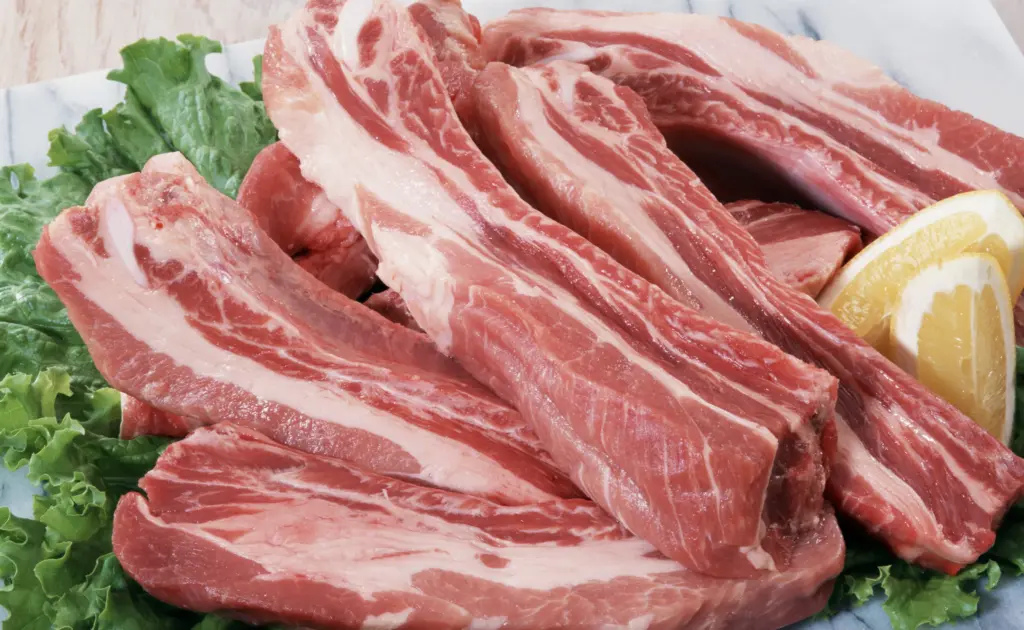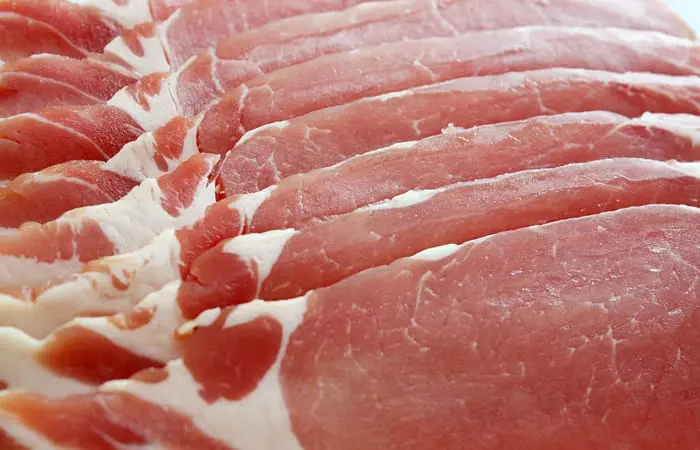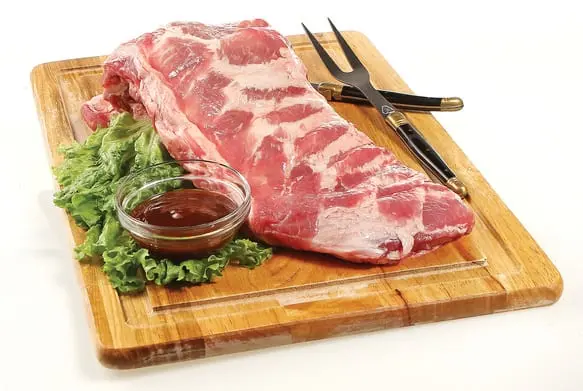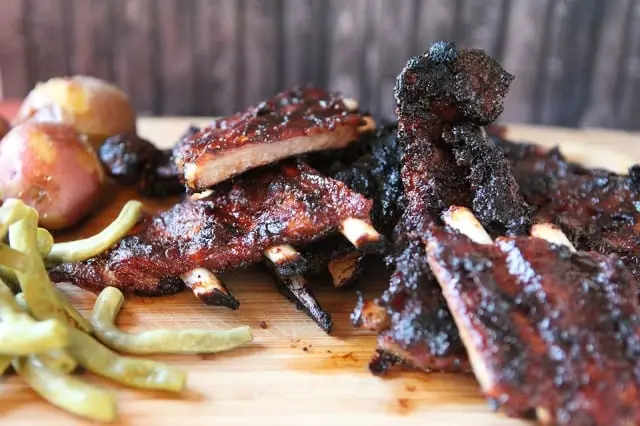Contents
Description
Pork is the most easily digestible meat after lamb, and pork fat is much less harmful than beef for the heart and blood vessels. Another distinctive feature of pork is the high content of B vitamins, which neither beef nor lamb can boast of. Young mothers are advised to eat pork legs, since the meat from this part of the pork carcass contributes to the production of breast milk.
Generally speaking, pork is different from other types of meat:
- lighter color of muscle tissue,
- the presence of layers of fat inside the meat – marbling,
- the presence of fat – a thick layer of subcutaneous fat,
- white internal fat.
The meat of adult animals is pale red in color, dense, with pronounced marbling. It should be clarified that well-fed animals will have a pink-red color with a gray tint, a tender and elastic consistency, while underfed animals will have a more juicy red color.
Pig meat is pale pink or pale red in color, with layers of fat, tender and dense.
It is generally accepted that the lighter and fatter the pork, the higher it is valued.
Pork meat is rich in zinc and magnesium, so eating it has a positive effect on the potency and work of the cardiovascular system. Pork also contains the amino acid lysine, which is essential for the proper formation of bones.
One serving of pork liver contains as much vitamin B12 as the human body needs for a month. Pork lard is rich in selenium and arachidonic acid, which, when consumed in moderation, makes it a good antidepressant.
Pork composition
The nutritional value
Caloric value 227 kcal
- Vitamin B1 (thiamine) 0.319 mg
- Vitamin B2 (riboflavin) 0.251 mg
- Vitamin B5 (pantogenic) 0.625 mg
- Vitamin B6 (pyridoxine) 0.574 mg
- Vitamin B12 (cobalamins) 0.38 mg
- Vitamin E (TE) 0.37 mg
- Vitamin PP (niacin) 4.662 mg
- Choline 59.7 mg
Macronutrients and Micronutrients
- Calcium 15 mg
- Magnesium 16 mg
- Sodium 81 mg
- Potassium 242 mg
- Phosphorus 141 mg
- Iron 0.91 mg
- Zinc 2.5 mg
- Copper 80 μg
- Manganese 0.01 mg
- Selenium 22 mcg
10 tips for choosing pork

- First tip – the market, not the store. Meat is not yogurt or biscuits in a standard package that you can take from the supermarket shelf without looking. If you want to buy good meat, it is best to go to the market, where it is easier to choose, and the quality is often higher. Another reason not to buy meat in stores is various dishonest tricks, which are sometimes used to make the meat look more appetizing and weigh more. It’s not that the market doesn’t do this, but at least you can look the seller in the eye.
- Second tip – a personal butcher
Those of us who have not embarked on the path of vegetarianism eat meat more or less regularly. The best thing to do in this situation is to get “your own” butcher who will know you by sight, offer the best cuts, give valuable advice and order meat for you if it is out of stock now. Choose a butcher who is humanly pleasant to you and sells decent goods – and do not forget to exchange at least a few words with him with every purchase. The rest is a matter of patience and personal contact. - Tip three – learn color
The butcher is a butcher, but it doesn’t hurt to figure out the meat yourself. The color of the meat is one of the main signs of its freshness: good beef should be confidently red, pork should be pinkish, veal is similar to pork, but more pink, lamb is similar to beef, but of a darker and more intense shade. - Tip four – inspect the surface
A thin pale pink or pale red crust from drying meat is quite normal, but there should be no extraneous shades or spots on the meat. There should be no mucus either: if you put your hand on fresh meat, it will remain almost dry. - Fifth tip – sniff
As with fish, smell is another good guide when determining the quality of a product. We are predators, and the barely perceptible fresh smell of good meat is pleasant for us. For example, beef should smell so that you want to immediately make a Tatar steak or carpaccio out of it. A distinct unpleasant smell suggests that this meat is no longer the first or even the second freshness; it is by no means worth buying. An old, proven way to sniff a piece of meat “from the inside” is to pierce it with a heated knife. - Sixth tip – study fat
Fat, even if you intend to cut it and throw it away, can tell a lot by its appearance. Firstly, it must be white (or cream in the case of lamb), secondly, it must have the correct consistency (beef must crumble, mutton, on the contrary, must be dense enough), and thirdly, it must not have an unpleasant or rancid odor. Well, if you want to buy not only fresh, but also high-quality meat, pay attention to its “marbling”: on a cut of really good meat, you can see that fat is dispersed over its entire surface. - Seventh tip – elasticity test
The same as with fish: fresh meat bounces when pressed and the hole you left with your finger is immediately smoothed out. - Eighth tip – buy frozen
When buying frozen meat, pay attention to the sound it makes when tapping, the even cut, the bright color that appears when you put your finger on it. Defrost meat gently, the longer the better (for example, in the refrigerator), and if it has been properly frozen, then, cooked, it will be almost indistinguishable from chilled. - Tip nine
When buying this or that cut, it is good to know where in the animal carcass it is and how many bones it contains. With this knowledge, you will not overpay for bones and will be able to correctly calculate the number of servings. - Tip ten
Often people, having bought a good piece of meat, spoil it beyond recognition when cooking – and there will already be no one to blame but themselves. When choosing meat, have a clear idea of what you want to cook, and feel free to share this with the butcher. Frying, stewing, baking, boiling in order to obtain broth, jelly or boiled meat – all these and many other types of preparation involve the use of different cuts. Of course, no one will forbid you to buy beef fillet and cook broth from it – but then you will overpay the money, and ruin the meat, and the broth will turn out so-so.
No matter what nutritionists say, pig meat has a number of positive qualities. With regular use of lean varieties, you can achieve a significant reduction in blood cholesterol levels and strengthen the walls of blood vessels. A well-thought-out composition of the menu will avoid many cardiac problems. Even fat contains fewer harmful elements than butter and eggs.
Large amounts of protein are a godsend for people who engage in strenuous exercise. Protein is an essential building block of muscle, and when it is lacking, the body begins to absorb its own fiber reserves. The constant inclusion of animal tissues in the diet allows the body to forget about the micronutrient deficiency.

Thanks to the unique combination of iron, iodine and enzymes, the raw material stimulates the functions of the hematopoietic organs. With anemia and injuries, a gentle diet is shown, which makes the regeneration of hemoglobin as efficient as possible. Doctors advise nursing women to use useful fibers to improve lactation and men to increase potency.
Pork meat is easily absorbed by the body, which helps to quickly fill the lack of nutrients and minerals. A properly cooked fillet improves the permeability of the gastrointestinal tract. The presence of a huge amount of enzymes cheers up.
A well-thought-out diet will bring maximum benefits to the body. In cold seasons, the human body needs more energy than during normal times. For natural heating, you can choose a lean popular product. There are no carbohydrates in boiled meat, which will have a positive effect on the figure.
Harmful properties
Despite all the advantages, pork is on the list of foods that are not recommended for people with certain health problems. The increased content of histamine causes an allergic reaction. The result will be:
- eczema;
- dermatitis;
- cholecystitis;
- furunculosis.

The normal functioning of the body can be knocked down by growth hormones, which are found in abundance in tasty fibers. Regular gluttony triggers dangerous pathological processes. In addition to obesity, a person is threatened with benign and malignant formations. Animal blood contains oncogenic agents that provoke cancer.
The human body and the pig have some biochemical similarities, so common diseases can be transmitted from livestock. From the lungs, the flu enters the sausage, which becomes the source of the spread of epidemics. The greatest danger to humans is posed by parasites living in muscle tissue.
The harm to meat is manifested in the high calorie content of raw materials and the presence of fat in the fibers. Excessive consumption of food can provoke exacerbation of diseases of the kidneys, liver and digestive system. Poor-quality products or violation of heat treatment rules lead to poisoning with toxins.
Pork taste qualities
Taste qualities largely depend on the breed, cultivation and diet of each animal, but basically the meat has a pronounced meaty taste, a little sweetish, juicy due to greasy veins. Has a pleasant aroma. Improper storage can negatively affect the taste, so it is not recommended to defrost and re-freeze, but it is best to purchase and cook chilled.
The meat is pink in color, in some parts it is dark pink, moist, has a fibrous structure. It boils well and cooks quickly, for which it is widely used in cooking.
Greasy streaks and white or cream-colored lard. By the way, it is by the color of the bacon that you can judge the freshness of the carcass. If the fat is yellow, it is better to refuse such a product.
Cooking applications

Pork is widely used in gastronomy and cooking; it lends itself perfectly to any processing. Meat can be dried, smoked, fried, boiled, marinated, baked, grilled, processed into minced meat. And also, delicious balyks and sausages are made from it.
Pork is successfully used in the cuisine of different nations of the world and is very often the main ingredient in national dishes. Who doesn’t know Ukrainian borscht and jellied meat, baked boiled pork, Hungarian pork ribs or French chops? First and main courses are made from meat perfectly; it is used in salads, appetizers and even baked goods. A record pork dish – a portion of fried meat with onions and spices weighing 3,064 kilograms! It was prepared in Mexico and served on a 42 meter long tray.
Pork goes well with various ingredients that nobly set off the taste and give a pleasant aftertaste, that is, with fruits and vegetables, berries, mushrooms, all kinds of sauces and spices. A glass of dry red wine perfectly emphasizes the taste.
The main feature of meat is that it can be cooked practically without fat, heat treatment takes a minimum of time, and the result, with the right approach and quality of the initial product, is always perfect and exceeds all expectations.
Canadian pork ribs

- Ingredients for Canadian Pork Ribs:
- Pork ribs – 800 g
- Fruit puree (apple, ready-made. You can use puree for baby food) – 80 g
- Ketchup – 80 g
- Brown sugar – 3 tbsp l.
- Lemon (squeeze juice) – 1/2 pc
- Soy sauce – 2-3 tbsp l.
- Black pepper (ground) – 1/2 tsp.
- Sweet paprika – 1/2 tsp
- Garlic (dry, powder) – 1/2 tsp
- Cinnamon (ground) – 1/2 tsp
Preparation
- Combine all ingredients (except meat, of course) in a suitable bowl.
- Cut the ribs so that there is one rib per serving. If the pieces are large and you will be cooking the meat in the oven, you can pre-boil them for 15-30 minutes. I didn’t. Place the meat in the sauce, coat each piece well and set aside in a cold place for at least 30 minutes to marinate.
- Place the ribs on a baking sheet, cover with foil and bake for one to one and a half hours at T220 C. If the meat leaks too much juice, drain it.
- Grease the ribs with the remaining sauce every 20-30 minutes. After 40 minutes, remove the foil and bake the meat until golden brown.
If the sauce remains, simmer the leftover sauce until the sugar is completely dissolved, and serve separately for those who like the ribs with a double portion of the sauce.
Enjoy your meal!










چقدر زر زدی تو این به اصطلاح مقاله آن🤮🤮🤮
گریل گوشت خوک با سیبزمینی سرخ کرده عالیه😘😘😋😋😋
खूप छान
من فک نمیکنم سگهای ولگرد و بیابانی و خیابانی هم گوشت گراز بخورن